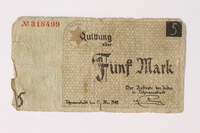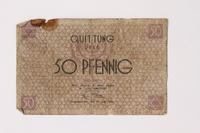Overview
- Brief Narrative
- 10 mark coin issued in the Łódź ghetto in Poland in 1943. Nazi Germany occupied Poland on September 1, 1940; Łódź was renamed Litzmannstadt and annexed to the German Reich. In February, the Germans forcibly relocated the large Jewish population into a sealed ghetto. All currency was confiscated in exchange for Quittungen [receipts] that could be exchanged only in the ghetto. The scrip and tokens were designed by the Judenrat [Jewish Council] and includes traditional Jewish symbols. The Germans closed the ghetto in the summer of 1944 by deporting the residents to concentration camps or killing centers.
- Date
-
issue:
1943
- Geography
-
manufacture:
Litzmannstadt-Getto (Łódź, Poland);
Łódź (Poland)
- Credit Line
- United States Holocaust Memorial Museum Collection, Gift of Barbara Hillson Abramowitz. In Honor of Irving J. Abramowitz.
- Markings
- obverse: GETTO / 1943
reverse, around outside: DER AELTESTE DER JUDEN• / •IN LITZMANNSTADT [JEWISH ELDERS]
reverse, center: 10
reverse, banner across 10: QUITTUNG UBER
reverse, bottom: MARK
Physical Details
- Language
- German
- Classification
-
Exchange Media
- Category
-
Money
- Object Type
-
Scrip (aat)
- Physical Description
- Circular, silver colored metal coin, possibly aluminum or magnesium. The obverse has an embossed design with a 6 pointed Star of David, German text, and the year in the center over a circular line interspersed with Stars of David. There is a circle etched around the outer rim. The reverse has an embossed design with the denomination 10 mark in the center crossed by a banner with German text. There is German text engraved in a circle near the depressed rim.
- Dimensions
- overall: | Diameter: 1.125 inches (2.858 cm)
- Materials
- overall : metal
Rights & Restrictions
- Conditions on Access
- No restrictions on access
- Conditions on Use
- No restrictions on use
Keywords & Subjects
Administrative Notes
- Legal Status
- Permanent Collection
- Provenance
- The coin was donated to the United States Holocaust Memorial Museum in 1992 by Barbara Abramowitz.
- Record last modified:
- 2022-07-28 18:22:06
- This page:
- https://collections.ushmm.org/search/catalog/irn6836
Download & Licensing
In-Person Research
- By Appointment
- Request 21 Days in Advance of Visit
- Plan a Research Visit
- Request to See This Object
Contact Us
Also in Irving J. Abramowitz collection
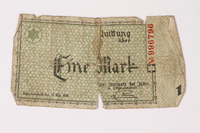
Łódź (Litzmannstadt) ghetto scrip, 1 mark note
Object
1 (eine) mark receipt issued in the Łódź ghetto in Poland in May 1940. Nazi Germany occupied Poland on September 1, 1939; Łódź was renamed Litzmannstadt and annexed to the German Reich. In February, the Germans forcibly relocated the large Jewish population into a sealed ghetto. All currency was confiscated in exchange for Quittungen [receipts] that could be exchanged only in the ghetto. The scrip was designed by the Judenrat [Jewish Council] and includes traditional Jewish symbols. The Germans closed the ghetto in the summer of 1944 by deporting the residents to concentration camps or killing centers.
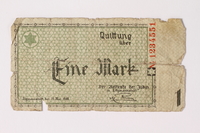
Łódź (Litzmannstadt) ghetto scrip, 1 mark note
Object
1 (eine) mark receipt issued in the Łódź ghetto in Poland in May 1940. Nazi Germany occupied Poland on September 1, 1939; Łódź was renamed Litzmannstadt and annexed to the German Reich. In February, the Germans forcibly relocated the large Jewish population into a sealed ghetto. All currency was confiscated in exchange for Quittungen [receipts] that could be exchanged only in the ghetto. The scrip was designed by the Judenrat [Jewish Council] and includes traditional Jewish symbols. The Germans closed the ghetto in the summer of 1944 by deporting the residents to concentration camps or killing centers.
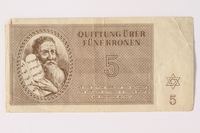
Theresienstadt ghetto-labor camp scrip, 50 kronen note
Object
Scrip, valued at 50 kronen, issued in the Theresienstadt (Terezin) ghetto-labor camp in 1943. All currency was confiscated from deportees upon entry and replaced with scrip and ration coupons that could be exchanged only in the camp. The Theresienstadt camp existed for 3.5 years, from November 24, 1941 to May 9, 1945. It was located in a region of Czechoslovakia occupied by Germany, renamed the Protectorate of Bohemia and Moravia, and made part of the Greater German Reich.

Theresienstadt ghetto-labor camp scrip, 1 krone note
Object
Scrip, valued at 1 krone, issued in the Theresienstadt (Terezin) ghetto-labor camp in 1943. All currency was confiscated from deportees upon entry and replaced with scrip and ration coupons that could be exchanged only in the camp. The Theresienstadt camp existed for 3.5 years, from November 24, 1941 to May 9, 1945. It was located in a region of Czechoslovakia occupied by Germany, renamed the Protectorate of Bohemia and Moravia, and made part of the Greater German Reich.
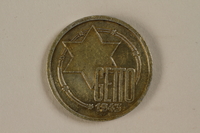
Łódź (Litzmannstadt) ghetto scrip, 10 mark coin
Object
10 mark coin issued in the Łódź ghetto in Poland in 1943. Nazi Germany occupied Poland on September 1, 1940; Łódź was renamed Litzmannstadt and annexed to the German Reich. In February, the Germans forcibly relocated the large Jewish population into a sealed ghetto. All currency was confiscated in exchange for Quittungen [receipts] that could be exchanged only in the ghetto. The scrip and tokens were designed by the Judenrat [Jewish Council] and includes traditional Jewish symbols. The Germans closed the ghetto in the summer of 1944 by deporting the residents to concentration camps or killing centers.

Star of David button
Object
Star of David badge
Object
Postage stamp, 3+5 zloty, commemorating Majdanek concentration camp issued in postwar Poland
Object
Postage stamp issued by Poland in 1946. It depicts a skeleton in a Nazi Uniform emptying a canister of Zyklon-B pellets over the barracks of Majdanek concentration camp. The stamp created public outrage and many felt it offended the memory of the thousands of people murdered there by the Germans. It was withdrawn about two months after first issue.



